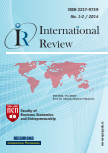Application of VaR (Value at Risk) method on Belgrade Stock Exchange (BSE) optimal portfolio
Application of VaR (Value at Risk) method on Belgrade Stock Exchange (BSE) optimal portfolio
Author(s): Siniša Miletić, Boris Korenak, Miloš LutovacSubject(s): Economy
Published by: Visoka škola za poslovnu ekonomiju i preduzetništvo
Keywords: market risk; optimal portfolio; Value at Risk (VaR); backtesting; EWMA; GARCH models; historical simulation
Summary/Abstract: The main objective of this study is to determine the adequacy of the measurement of market risks of financial institutions in Serbia by the method of Value at Risk (VaR). For investors, in the current global financial crisis, it is particularly important to accurately measure and allocate risk and efficiently manage their portfolio. Possibility of application of VaR methodology, which is basically designed and developed for liquid and developed markets, should be tested on the emerging markets, which are characterized by volatility, illiquidity and shallowness of the market. Value of VaR in this study was calculated using historical and parametric methods and backtesting analysis was used to verify the adequacy of the application of VaR models. Backtesting VaR model performance analysis was conducted to compare the ex-ante VaR estimate to the ex-post returns. The empirical results show that parameter exponentially weighted moving average model gives lower values at risk in both cases (95% and 99%) due to the fact that this method assigns weights to more recent returns while our portfolio is exposed to a lower volatility in recent time. Based on the results of Kupiec's and Christoffersen's test, it was observed that VaR estimates obtained by both, parametric and historical simulation, give a good prediction of market risk, at 95% and 99% confidence level.
Journal: International Review
- Issue Year: 2014
- Issue No: 1-2
- Page Range: 142-158
- Page Count: 17
- Language: English

